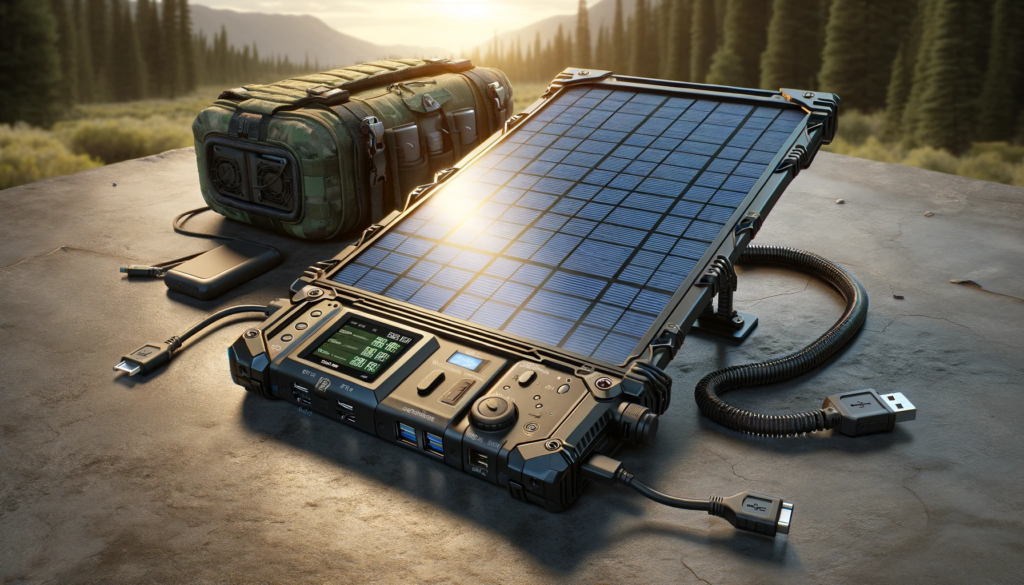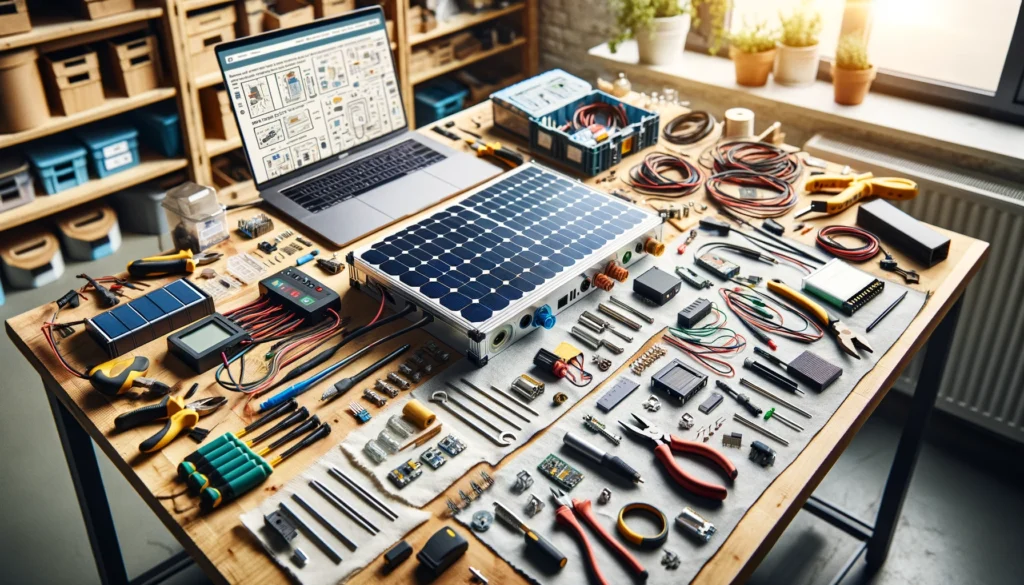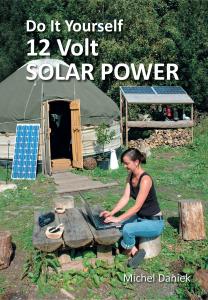
Looking to keep your devices powered while off the grid? Solar battery chargers provide an ideal solution when away from electrical outlets. These chargers harness renewable energy from the sun through solar panels. High-efficiency models maximize solar energy harvesting during the day to store power in internal battery banks. The stored solar power can then be used on-demand to charge smartphones, tablets, cameras, laptops, and more anytime.
Solar battery chargers and generators deliver eco-friendly power by replenishing reserves directly through sunlight. No longer limited by finite battery life, advanced portable solar models can even handle powering small appliances and tools for true energy independence. Choosing the right solar battery charger means balancing power output capabilities, portability, and features to fit your needs remotely.
In this guide, we’ll explore the unique benefits of solar battery chargers for off-grid adventures. From understanding key specifications like solar panel wattage ratings and battery capacity to evaluating essential features like AC outlets, we’ll cover everything to consider in picking the perfect solar companion for camping, RVing, and alternative living powered by the sun.
Main Components of Solar Charging Systems

While portable solar battery chargers come in various formats, they all rely on a few key components to collect, regulate, store, and convert solar energy. Understanding the role each part plays will help you select the right system for your needs.
Solar Panels: This is the main energy harvesting component. Solar panels contain photovoltaic cells that convert sunlight into direct current (DC) electricity. Key factors are the panel wattage, cell material, and whether rigid or flexible.
Charge Controller: The charge controller regulates the current flowing from the solar panels to safely charge batteries. It prevents overcharging and damage. Controllers come in PWM or MPPT varieties, with the latter being more efficient.
Battery: The battery stores the harvested solar energy for on-demand use when off-grid. Lithium iron phosphate (LFP) batteries are recommended as they offer advantages over other battery chemistries. Compared to lead acid batteries, LFP batteries are lighter in weight and hold their charge longer. LFP also demonstrates greater cycle life versus lithium-ion batteries, with over 2000 recharge cycles compared to 300-500 cycles typically for lithium-ion. The high cycle count indicates an extended lifespan. In addition, LFP chemistry is considered safer and more stable. When reviewing solar generators, consider these battery advantages that LFP technology provides for off-grid renewable energy storage.
Inverter: Inverters convert the DC power from the solar panels and batteries into alternating current (AC) that powers appliances, tools, lights, etc. Pure sine wave inverters offer the best performance for sensitive devices.
Wiring: Cables and wiring connect all the components into a working system. Proper gauges are needed to handle solar currents.
With the key pieces of solar charging systems covered, let’s look at some portable solar solutions to keep devices powered up on the go. Starting small, we’ll explore using foldable solar panels to directly charge phones, cameras, and gadgets while off-grid.
Portable Foldable Solar Panel Chargers
Portable foldable solar panels offer an eco-friendly way to charge devices directly using the sun’s energy. These ultra-portable panels contain solar cells and a charge controller to send power directly to your phone, tablet, battery pack, etc.
Benefits of quality foldable solar panels:
- Extreme portability: Under 2 lbs for easy carrying in backpacks.
- Dual USB outputs: Charge multiple devices simultaneously.
- Advanced efficiency: Faster charging than cheaper panels.
- Durable materials: Withstand outdoor exposure.
- Affordable price: Lower cost than units with batteries.
Limitations to consider:
- No battery for energy storage: Can’t charge without sunlight.
- Slow charge times: Lower wattage than wall outlets or larger portable systems.
- Positioning required: Must adjust the angle toward the sun.
For powerful yet lightweight charging in a foldable format, consider the Jackery SolarSaga 100W Solar Panel. This panel leverages high-efficiency monocrystalline solar cells and offers 100W output. With both USB-C and USB-A ports, it provides compatibility with various devices. It features a weather-resistant design and includes a stand for easy positioning
While not designed for large appliances, when used properly, foldable solar panels like this offer the advanced efficiency of renewable solar in a packable panel perfect for hiking, camping, and emergency preparedness kits. With some smart adjustments towards the sun, quality foldable solar panels enable staying powered solely by the sun’s abundant energy.
Check out Jackery’s SolarSaga 100W Solar Panel on Homestead Supplier
Portable Solar Chargers with Batteries
For charging on the go with built-in energy storage, some portable solar chargers integrate solar panels, charge controllers, and battery banks. These integrated units harvest sunlight to charge up the internal battery, which then powers connected devices as needed.
Benefits of integrated portable solar chargers:
- Built-in batteries store energy for use anytime without direct sunlight.
- Advanced units charge devices first before routing power to the battery, preventing overcharging.
- All-in-one convenience rather than separate components.
- Can sustainably power devices for days of off-grid use from the stored solar energy.
Limitations to consider:
- Extra weight and bulk from built-in battery packs.
- Battery capacity is finite (of course).
- Solar alignment affects charging performance.
With smart coordination between solar harvesting and energy storage, integrated solar battery chargers leverage sunlight to allow flexible device charging on the go.
One such integrated portable solar charger is FEELLE’s solar charger power bank, which combines high-efficiency solar panels with a substantial 25,000 mAh battery capacity. This allows harnessing sunlight during the day to charge devices multiple times from the stored energy. The integrated design intends to enable optimized coordination between the solar panels and the battery.
Check out FEELLE’s 25,000 mAh Solar Charger Power Bank on Amazon
Comprehensive Off-Grid Power with Solar Generators

For those needing serious off-grid power to run appliances, tools, and more, solar generators are the ultimate portable solar charging solution. These integrated systems combine solar panels, charge controllers, batteries, and inverters into complete renewable energy stations. Solar generators sometimes come as full kits including solar panels, while other models require purchasing panels separately.
Benefits provided by solar generators:
- AC power output: Inverters allow the powering of most household electronics and appliances.
- Higher capacity: Large batteries store ample energy for extended use (500Wh to over 2000Wh).
- Replenish from the sun: Attach solar panels during the day to recharge the battery.
- Recharge from AC: Most can also charge from a home or campsite electrical outlet.
- Pure sine wave: Those with pure sine wave tech have clean power suitable for sensitive items like laptops.
Downsides to weigh:
- Heavy and bulky: Larger batteries and components reduce portability.
- Higher cost: All the capabilities come at a $500 to $2,000+ price point.
A capable option for renewable power on the go is the BLUETTI EB3A Portable Power Station. This compact powerhouse packs a 268Wh lithium iron phosphate (LiFePO4) battery and outputs up to 600W of clean power, enough to run small appliances like mini-fridges, CPAP machines, and laptops off-grid.
With fast charging (80% in 30 minutes) and a variety of outputs (including AC, USB, and even wireless), it offers versatile charging for numerous devices. BLUETTI emphasizes the EB3A’s role in supporting a sustainable lifestyle and its compatibility with solar panels via the built-in MPPT charge controller.
While portable solar generators demand bigger upfront investment, their durable battery and convenient solar recharging capabilities provide dividends over conventional gas generators that require ongoing fuel purchases.
Check out BLUETTI’s EB3A Portable Power Station on Homestead Supplier
Building Custom DIY Solar Charging Kits

For expert solar enthusiasts wanting maximum flexibility, DIY solar charging kits allow you to handpick individual components to create fully customized off-grid systems.
Benefits of DIY solar charging kits:
- Choose your adventure: Select exactly the features and capacity you need.
- Top tier components: Piece together best-in-class panels, charge controllers, etc.
- Completely customizable: Tailor the perfect setup for your specific use case.
- Educational experience: Learn in-depth how solar systems work.
- Potential cost savings: Carefully sourced components may cost less overall.
Challenges to factor:
- Time and effort: Requires significant research and legwork to source parts.
- Installation work: Must handle wiring and connections yourself.
- Future compatibility: Components may not always work together seamlessly.
For collecting the sun’s rays, consider the BLUETTI PV200 200-watt Solar Panel. This powerful panel features monocrystalline solar cells with impressive efficiency (up to 23.4%) for fast charging, even in less-than-ideal light conditions. The PV200 is built with longevity in mind, utilizing durable ETFE material and an IP65 waterproof rating, making it suitable for various outdoor adventures. It’s designed for compatibility with BLUETTI power stations, emphasizing its role in building off-grid power setups.
Check out BLUETTI’s PV200 200-watt Solar Panel on Homestead Supplier
To manage energy flow from your solar panels to your battery, consider the Rich Solar 40 Amp MPPT Solar Charge Controller. It supports various battery types (sealed, gel, flooded, lithium) for flexibility. MPPT technology ensures you get the most out of your panels, reducing reliance on grid power. Built-in safety features protect your battery investment.
Check out Rich Solar’s 40 Amp MPPT Solar Charge Controller on Homestead Supplier
For storing the energy collected by your solar panels, consider the Rich Solar 12V 200Ah LiFePO4 Lithium Iron Battery. This long-lasting battery is built with LiFePO4 chemistry, known for its exceptional cycle life (over 5,000 cycles) and extended lifespan (10+ years). This longevity means less frequent replacements and minimized waste over time. For added peace of mind, the built-in battery management system (BMS) ensures safe and reliable operation.
Check out Rich Solar 12V 200Ah LiFePO4 Lithium Iron Battery on Homestead Supplier
To convert the DC power stored in your battery into usable AC electricity for appliances and devices, the Rich Solar 1000 Watt Pure Sine Wave Inverter is a solid choice. It delivers clean power ideal for sensitive electronics and features various built-in protection mechanisms, ensuring the safe and reliable operation of your off-grid system. Additionally, its USB port provides convenient charging for smaller devices.
Check out Rich Solar’s 1000 Watt Pure Sine Wave Inverter on Homestead Supplier
By researching and selecting your best-in-class components like these, DIY solar kits allow crafting fully customized off-grid solutions tailored to your unique power needs and passions. The benefits of education and system flexibility outweigh the upfront legwork.
Harnessing the Power of Portable Solar Chargers
As we’ve seen, portable solar battery chargers unleash the limitless potential of the sun in a transportable format. Recent advancements have expanded capabilities dramatically, from bare-bones panels to fully integrated generators. Understanding the components helps you choose the right system for your needs.
For basic charging of phones and gadgets directly, lightweight foldable panels offer an affordable eco-friendly solution. Integrated solar chargers with built-in batteries provide convenient power storage for flexible charging on the go. More advanced solar generators can power a wide range of electronics and appliances anywhere with AC outlets and ample battery capacity. Or you can build a fully customized kit picking each component yourself.
With climate change driving the adoption of renewable energy, portable solar battery chargers make tapping into clean solar power possible anywhere. Whether you’re a backpacker, RVer, or homesteader, this guide outlines the range of solar charging options from portable to industrial strength. The sun provides endless free energy if you have the right kit to harvest it. Solar battery chargers empower you to leverage that abundant renewable power and reduce reliance on fossil fuels.
Disclosure: This article contains affiliate links to products. We may receive a commission for purchases made through these links at no additional cost to you. All opinions are our own and we only recommend products we believe in that align with the topic and our readers’ interests.



